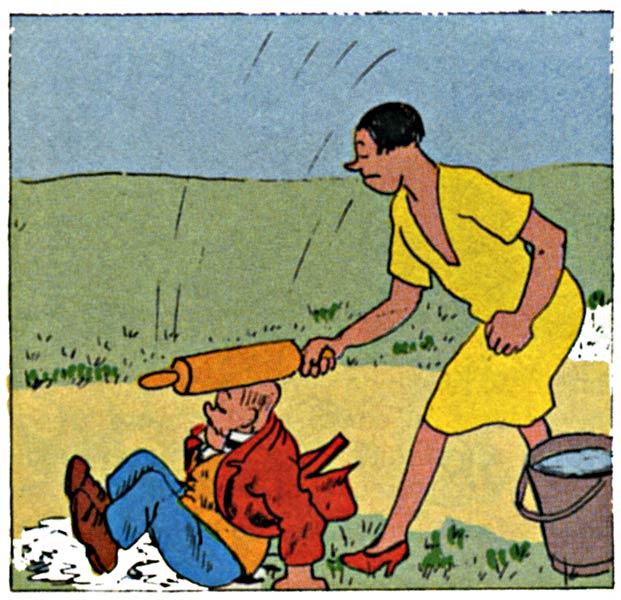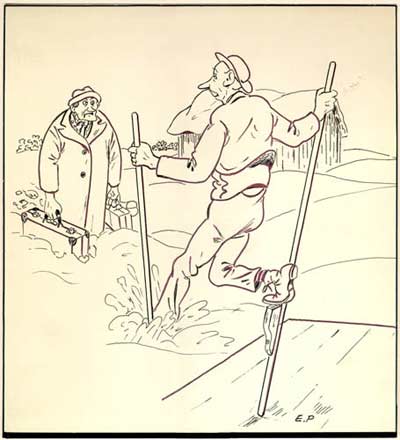Elov Persson was an early Swedish comic artist, and the creator of the country's longest-running series: 'Kronblom' (1927) and 'Agust och Lotta' (1928), which are still in production today.. Both have become cultural icons in Sweden. The series has always been continued within the Persson dynasty. First by Ingvar Persson and Gunnar Persson , in turn succeeded by their children Jonas Persson, Bia Melin and Lasse Persson.
Early life and career
Elov V. Persson was born in 1894 in the station house of Hästbo, a settlement in rural Gästrikland. He grew up in a poor household, together with four other siblings. His mother died when he was two years old. He found some joy in drawing after discovering the work of Albert Engström and other cartoonists. Elov left school after the seventh grade, and then earned money for his family in the local sawmill and then as a bricklayer. He was later employed by a food factory in Gävle. In the evenings, Persson found the time to pick up the drawing pen again, with the desire to become an advertising artist. He managed to sell funny drawings and comic strips to the local worker's newspaper Arbetarbladet and the humor magazine Kasper from Stockholm. Realizing he had more success selling jokes, Persson decided this was the path he would follow.
Lars Petter / Kaspersson
On 17 December 1924, Arbetarbladet published Persson's strip 'När Lars Petter skulle slakta julgrisen'. The main character, an elderly working class figure called Lars Petter, can be considered a predecessor to the author's future creations. In the following year, he introduced his first recurring character in the magazine Smålänningen. The elderly 'Kaspersson' (1925-1929) was inspired by Oscar Jacobsson's 'Adamson', and appeared on a weekly basis. He left the series after four years, because his new employer Åhlén & Åkerlunds demanded exclusivity. 'Kaspersson' was continued in later years by Einar Lindberg, either in solo strips or as a guest character in Lindberg's 'Sympatiska Filip' series.
Kronblom
In 1929, Elov Persson and his wife Signe settled in Storvik, where they remained until 1945. They then spent the rest of their lives in the small village Torsåker in the Hofors municipality. The rural countryside of Gästrikland was also the setting for both Persson's signature series. At age 22, Persson managed to sell the publishing house Åhlén & Åkerlunds his idea for the comic strip 'Kronblom'. Receiving a much higher rate than for 'Kaspersson', the young artist could now leave his daytime job. 'Kronbloms äventyr' made his debut as full page in color in the weekly Allt för Alla on 17 July 1927. The series became eventually known as simply 'Kronblom', and was transferred to the weekly magazine Vårt Hem in 1932. An annual 'Kronblom' Christmas book with reprints appears since 1930. In 1956 it got an additional publication in the comic magazine 91:an. Persson was a modern cartoonist for his time, as he was one of the few to use speech balloons instead of text captions.
The lanky Kronblom and his wife Malin form a likeable elderly couple, who live a peaceful life in the fictional country village Vinkelboda. Kronblom enjoys fishing and hunting, much like his spiritual father, but is most of all lazy. He spends hours on end hanging around on the sofa. Malin's attempts to have him find a job, or to do a chore, are generally without success. The biggest nuisance in Kronblom's quiet life is however his mother-in-law, "Svärmor". She has a tendency to stay at their home for weeks, criticizing and bossing the poor lazybones around. At moments like these Kronblom suddenly has more energy than usual, but mostly to play pranks on her to drive her away.
Persson was a talented portrayer of people, which gave his characters an authentic flavor. He also tackled sensitive subjects like religion, racism and death, which sometimes led to censorship from his publishers. Kronblom was the subject of two live action films starring Ludde Gentzel in the title role: 'Kronblom' (1947) and 'Kronblom kommer till stan' (1949). Gits Olsson wrote a radio play based on the character in the 1950s.
'Agust och Lotta'.
Agust och Lotta
Far less likeable were the protagonists in Elov Persson's other series, 'Agust och Lotta'. Following the succes of 'Kronblom', his publisher asked him to create another series for its magazine Hela Världen in 1928. At the start, Agust Vråk was a pampered bachelor sent to the city by his father to earn his own money. He has a quick win however, and continues his laidback life full of partying, dancing and playing cards. He marries a certain Lotta Svensson, after which the title changes from 'Agust' to 'Agust och Lotta'. This series paints a far less idyllic picture of marriage than 'Kronblom'. The stubborn pair constantly nag at each other, and the dominant Lotta regularly attacks her husband with breadcrumbs and frying pans. She is also openly courted by a third party, called Russinkvist. Agust's son Jöns is introduced in 1934, a relic from a youth romance.'Agust och Lotta' moved to Hela Världen's successor Min Värld in 1964, while the comic also appeared in the comic magazines 91:an, Åsa-Nisse and its own annual Christmas books. In the 1980s the feature was transferred to the rural oriented magazine Land.
Recognition
Elov Persson won the 1966 Adamson Award in the category "Best Swedish comic-strip (or comic book) cartoonist" for his entire body of work.
Final years and death
Elov Persson handed over his signature series 'Kronblom' to his son Gunnar Persson in 1967. He continued to draw 'Agust och Lotta' for three more years. He died one day before his 76th birthday, when he suffered a heart attack during a fishing trip with his son Ingvar.
Legacy and influence
Ingvar Persson then took over 'Agust och Lotta'. Both series are by now continued by their creator's grandchildren. Gunnar's son Jonas Persson is responsible for 'Kronblom', while Ingvar's daughter Bia Melin draws 'Agust och Lotta'. Ingvar's son Lasse took over his father's solo creation 'Frid och Fröjd'. By 2014, Bia Melin's son Johannes Melin has been working with his mother on the 'Agust och Lotta' annuals. So by now, four generations have contributed to these iconic creations.
'Kronblom'.
'Kronblom' (1927) and 'Agust och Lotta' (1928), along with Rudolf Petersson's '91:an' (1932) are the longest running comic series in Sweden. All three have earned their rightful spot in the country's cultural heritage; Kronblom's name has even become synonymous with laziness and distrust of authority. The lasting power of these series is also ground for anachronisms. Both 'Kronblom' and 'Agust och Lotta' still dress and live like it's the 1930s - they still heat their houses with wood - while modern cars and equipment are also gradually introduced in the stories.
The cultural importance of Persson's creations is illustrated by the statues of Kronblom and Agust in Elov Persson's hometown Torsåker and another one of Kronblom in Gunnar Persson's hometown Örebro. Kronblom has been the mascot of the Swedish association football team Örebro SK since 1987. The site outside Persson's former house in Bäckebro (outside Gävle) was named Kronblomsplan and was provided with a specially designed park bench on 19 June 2004. It was the place where the artist lived when he created his character in 1927. Persson's house in Torsåker is nowadays known as the "Kronblomsvillan" (Kronblom's villa). The Wadköping museum in Örebro has a replica of the interior of Kronblom's house, complete with puppets of Kronblom, Malin and Svärmor.








